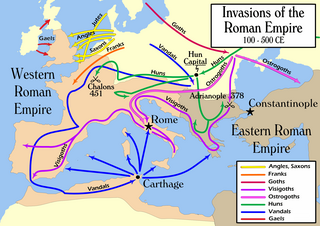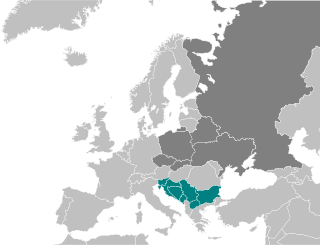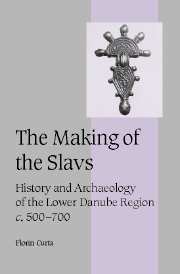
The Migration Period, also known as the Barbarian Invasions, was a period in European history marked by large-scale migrations that saw the fall of the Western Roman Empire and subsequent settlement of its former territories by various tribes, and the establishment of the post-Roman kingdoms.
Several theories, in great extent mutually exclusive, address the issue of the origin of the Romanians. The Romanian language descends from the Vulgar Latin dialects spoken in the Roman provinces north of the "Jireček Line" in Late Antiquity. The theory of Daco-Roman continuity argues that the Romanians are mainly descended from the Daco-Romans, a people developing through the cohabitation of the native Dacians and the Roman colonists in the province of Dacia Traiana north of the river Danube. The competing immigrationist theory states that the Romanians' ethnogenesis commenced in the provinces south of the river with Romanized local populations spreading through mountain refuges, both south to Greece and north through the Carpathian Mountains. Other theories state that the Romanized local populations were present over a wide area on both sides of the Danube and the river itself did not constitute an obstacle to permanent exchanges in both directions; according to the "admigration" theory, migrations from the Balkan Peninsula to the lands north of the Danube contributed to the survival of the Romance-speaking population in these territories.
The Vistula Veneti, also called Baltic Veneti or Venedi, were an Indo-European people that inhabited the lands of central Europe east of the Vistula River and the Bay of Gdańsk. Ancient Roman geographers first mentioned Venedi in the 1st century AD, differentiating a group of peoples whose manner and language differed from those of the neighbouring Germanic and Sarmatian tribes. In the 6th century AD, Byzantine historians described the Veneti as the ancestors of the Slavs who, during the second phase of the Migration Period, crossed the northern frontiers of the Byzantine Empire.

Kuber was a Bulgar leader who, according to the Miracles of Saint Demetrius, liberated a mixed Bulgar and Byzantine Christian population in the 670s, whose ancestors had been transferred from the Eastern Roman Empire to the Syrmia region in Pannonia by the Avars 60 years earlier. According to a scholarly theory, he was a son of Kubrat, brother of Khan Asparukh and member of the Dulo clan.

Dervan or Derwan was an early duke of the Sorbs.

South Slavs are Slavic people who speak South Slavic languages and inhabit a contiguous region of Southeast Europe comprising the eastern Alps and the Balkan Peninsula. Geographically separated from the West Slavs and East Slavs by Austria, Hungary, Romania, and the Black Sea, the South Slavs today include Bosniaks, Bulgarians, Croats, Macedonians, Montenegrins, Serbs and Slovenes.

Aladzha Monastery is a medieval Orthodox Christian cave monastery complex in northeastern Bulgaria, 17 km north of central Varna and 3 km west of Golden Sands beach resort, in a protected forest area adjacent to the Golden Sands Nature Park.
The Early Middle Ages in Romania started with the withdrawal of the Roman troops and administration from Dacia province in the 270s. In the next millennium a series of peoples, most of whom only controlled two or three of the nearly ten historical regions that now form Romania, arrived. During this period, society and culture underwent fundamental changes. Town life came to an end in Dacia with the Roman withdrawal, and in Scythia Minor – the other Roman province in the territory of present-day Romania – 400 years later. Fine vessels made on fast potter's wheels disappeared and hand-made pottery became dominant from the 450s. Burial rites changed more than once from cremation to inhumation and vice versa until inhumation became dominant by the end of the 10th century.

The Antes or Antae were an early Slavic tribal polity of the 6th century CE. They lived on the lower Danube River, in the northwestern Black Sea region, and in the regions around the Don River. Scholars commonly associate the Antes with the archaeological Penkovka culture.

Much of the territory of the modern state of Serbia was part of the Roman Empire and later the Eastern Roman Empire. In particular, the region of Central Serbia was under Roman rule for about 800 years, starting from the 1st century BC, interrupted by the arrival of the Slavs into the Balkans during the 6th century, but continued after fall of the First Bulgarian Empire in the early 11th century and permanently ended with the rise of the Second Bulgarian Empire in the late 12th century. The territories were administratively divided into the provinces of Moesia, Pannonia and Dardania. Moesia Superior roughly corresponds to modern Serbia proper; Pannonia Inferior included the eastern part of Serbia proper; Dardania included the western part of Serbia proper. After its reconquest from the Bulgarians by Emperor Basil II in 1018, it was reorganized into the Theme of Bulgaria.

The early Slavs were speakers of Indo-European dialects who lived during the Migration Period and the Early Middle Ages in Central, Eastern and Southeast Europe and established the foundations for the Slavic nations through the Slavic states of the Early and High Middle Ages. The Slavs' original homeland is still a matter of debate due to a lack of historical records; however, scholars generally place it in Eastern Europe, with Polesia being the most commonly accepted location.

The Penkovka culture is an archaeological culture in Ukraine, Moldova and reaching into Romania. Its western boundary is usually taken to at the middle Prut and Dniester rivers, where contact with the Korchak culture occurs. Its bearers are commonly identified as the Antes people of 6th-century Byzantine historiography.
Florin Curta is a Romanian-born American archaeologist and historian who is a professor of medieval history and archaeology at the University of Florida. Curta is known for an unorthodox approach and interpretation of the ethnogenesis of the Early Slavs, a hypothesis published first in The Making of the Slavs: History and Archaeology of the Lower Danube Region (2001), and met with negative criticism.
Boz was the king of the Antes, an early Slavic people that lived in parts of present-day Ukraine. His story is mentioned by Jordanes in the Getica (550–551); in the preceding years, the Ostrogoths under Ermanaric had conquered a large number of tribes in Central Europe, including the Antes. Some years after the Ostrogothic defeat by the invading Huns, a king named Vinitharius, Ermanaric's great-nephew, marched against the Antes of Boz and defeated them. Vinitharius condemned Boz, his sons, and seventy of his nobles, to crucifixion, in order to terrorize the Antes. These conflicts constitute the only pre-6th century contacts between Germanics and Slavs documented in written sources.
The Drougoubitai, also Drogobitai or Dragobitai, variously anglicized as Drugubites, Drogubites, Druguvites, Draguvites etc., were a South Slavic group (Sclaveni) who settled in the Balkans in the 7th century. Two distinct branches are mentioned in the sources, one living in medieval Macedonia to the north and east of Thessalonica and around Veroia.
The Belegezites were a South Slavic (Sklavenoi) tribe that lived in the area of Thessaly in the Early Middle Ages. They are one of the tribes listed in the Miracles of Saint Demetrius.
Strymonites or Strymonian Slavs were a tribe of Sclaveni who settled in the region of the river Strymon (Struma) in eastern parts of the historical region of Macedonia.
The Baiounitai or Vayunites were a Sclavene tribe which settled the region of Macedonia at the end of 6th century. The Baiounitai initially settled in the region west of Thessalonica. They belonged to a group of Slavic tribes that unsuccessfully tried to capture the city at the beginning of the 7th century, after which they are believed to have migrated to the region of northern Epirus, between Ioannina in Greece and Himara in Albania.

Samo's Empire is the historiographical term for the West Slavic tribal union established by King ("Rex") Samo. It existed between 623/631 and 658 in Central Europe. The extent of Samo's power before and after 631 is disputed.
This is a select bibliography of post-World War II English-language books and journal articles about the Early Slavs and Rus' and its borderlands until the Mongol invasions beginning in 1223. Book entries may have references to reviews published in academic journals or major newspapers when these could be considered helpful.








